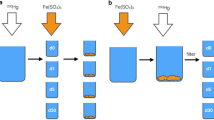Abstract
A study of total Hg (Hg) and methylmercury (MeHg) was performed in a 40 mgd capacity municipal sewage treatment plant in which elemental Hg was used as a seal in 3 trickling filter center columns. Each seal contains several hundred kg of Hg. The seals have leaked repeatedly over time, prompting the current remediation study and ongoing replacement of the Hg seals with mechanical seals. A mass balance conducted three times while the seals were in place showed that the plant acted as a net source of both Hg and MeHg during normal operation. The average amount of Hg released in sludge plus effluent was 157 g Hg and 0.4g MeHg/d. Of this total, 138 g Hg and 0.3 g MeHg were in excess of influent wastewater, and were contributed by the WTP itself. About 95% of the total Hg was released in sludge, with only 6 to 7 g/d released to the receiving water body. However, on average, about 70% of the MeHg leaving the plant was released to the river. Effluent MeHg concentrations were 4–6 ng/L. The plant components that acted as the major sources of both total and MeHg within the plant were the trickling filters (TFs). Metallic Hg accidentally lost from the center column seals has accumulated in the rock filter media and underbedding of the tricking filters. MeHg production across the TFs was positively related to the Hg concentration in each of the TFs. A substantial fraction of the total Hg but not of MeHg was lost to sludge in each settling step. About 50% of the remaining MeHg appeared to be degraded during the tertiary aeration step.
Similar content being viewed by others
References
Balogh, S. and L. Liang. 1995. Wat. Air Soil Poll. This volume.
Bloom, N. 1989. Can. J. Fish Aquat. Sci. 46: 1131–1140.
Bloom, N. and W.F. Fitzgerald. 1988. Anal. Chim. Acta 208:151–161.
Entech Engineering. 1993. City of Reading Wastewater Treatment Plant Mercury Investigation Work Plan. 68 pp.
Fitzgerald, W. and C.J. Watras. 1989. Sci. Tot. Environ., 87/88: 232–237.
Gill, G.A. and W.F. Fitzgerald. 1987. Marine Chem. 20: 227–243.
Gilmour, C.C., E.A. Henry and R. Mitchell. 1992. Environ. Sci. Technol. 26:2281–2287.
Gilmour, C.C. and E.A. Henry. 1991. Environ. Poll. 71: 131–169.
Horvat, M., N.S. Bloom and L. Liang. 1993a. Anal. Chim. Acta 282: 135–152.
Horvat, M., L. Liang and N.S. Bloom. 1993b. Anal. Chim. Acta 282: 153–168.
Author information
Authors and Affiliations
Rights and permissions
About this article
Cite this article
Gilmour, C.C., Bloom, N.S. A case study of mercury and methylmercury dynamics in a Hg-contaminated municipal wastewater treatment plant. Water Air Soil Pollut 80, 799–803 (1995). https://doi.org/10.1007/BF01189731
Issue Date:
DOI: https://doi.org/10.1007/BF01189731




